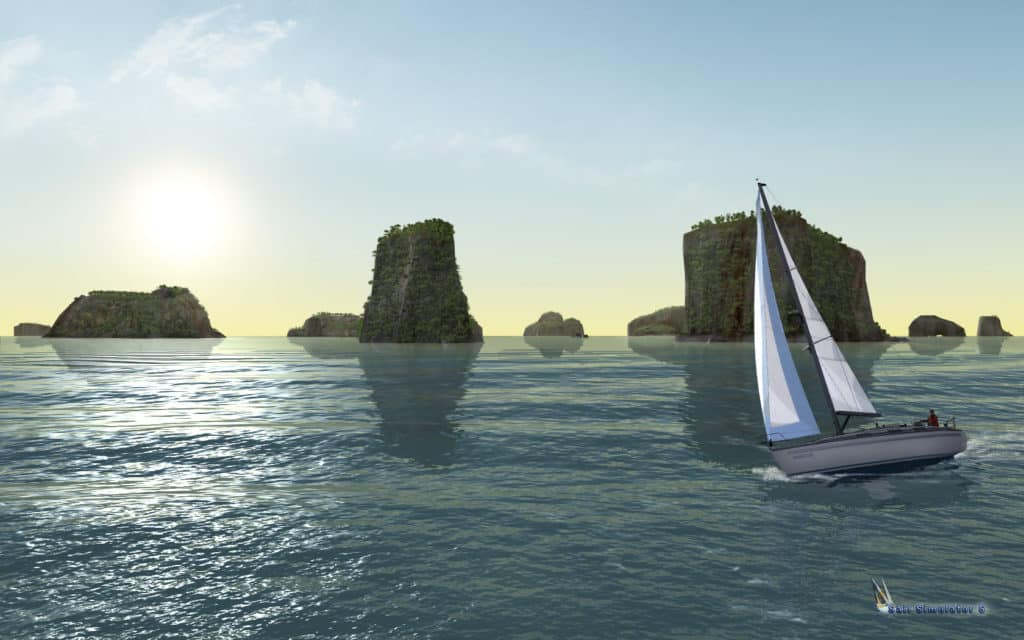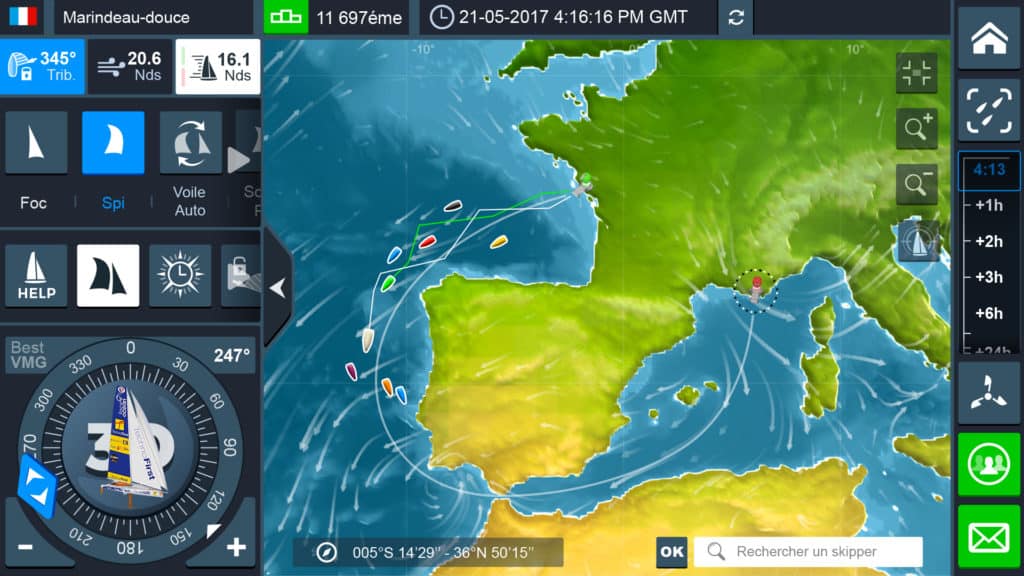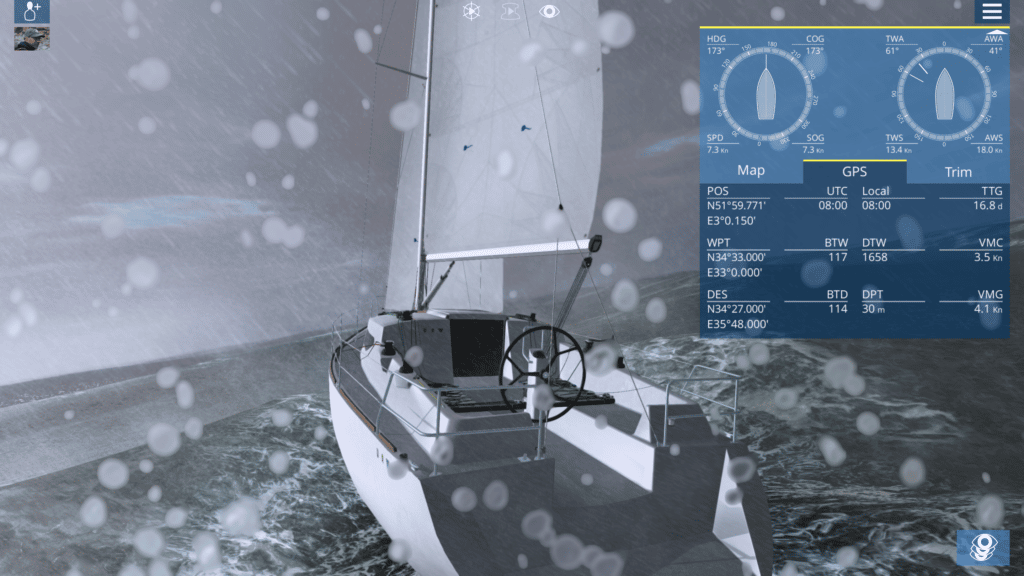
I was raised aboard keelboats, and there was little danger of my parents’ Catalina 27, or later, their C&C 37, flashing their keels at the sun on a breezy day. But our yacht club’s aging Blue Jay fleet was a different proposition. I’ll admit it: I wasn’t particularly fond of windy days when I was a junior sailor and learning the dinghy-sailing ropes aboard these cold-molded trainers.
Wind likely involved capsizing and swamping, and I can still remember eyeing the deciduous trees along Interstate 95, en route to class, for evidence of scary breeze. While I knew there was no substitute for on-the-water experience, my 10-year-old self would have welcomed an opportunity to improve my skill set without the threat of struggling to right a capsized Blue Jay in Long Island Sound’s questionably clean waters circa 1986.
Fortunately for me, Lasers and big boats soon followed (as did stricter environmental regulations), and I learned to love big-breeze days. But even at the not-so-wise age of 10, I understood why some junior sailors opted for tennis lessons the following summer.
The world has changed significantly in the three decades since, and one important evolution for aspiring and already-salty sailors alike has been the arrival of increasingly sophisticated sailing software that’s available for smartphones, tablets and PCs. While nothing will ever replace hard-won miles, today’s generation of sailing applications, simulators and learn-to-sail multimedia tools are designed to help smooth out sailing’s learning curves — ideally in conjunction with real-world instruction and practice — when your busy schedule permits, rather than when Mother Nature allows. Here’s a look at the kinds of software-based platforms that are available and the sorts of lessons they can help to teach and reinforce.
As with many multimedia offerings, it’s tricky to find a perfectly shaped category for many of the products. But in general terms, they can be described as games, sailing simulators and technology-based instructional courses.
Given the worldwide popularity of interactive and educational video games, it’s little surprise that multimedia tools such as Sailaway have approached sailing instruction with a gamelike environment in which players can improve their knowledge, “race” other players online and even test their newfound navigation skills using real-world weather conditions that the game incorporates through GRIB files that it automatically downloads.
“You can learn the basics: tacking, jibing, trimming sails, race tactics and navigation,” says Richard Knol, Sailaway’s developer. “The game uses all the buoys and lights from openseamap.org, and in the future, we’ll add navigating by the stars because we made sure the game already displays all the celestial positions in the right place.”
At present, Sailaway, which launched last April, is available for both Windows and Apple’s OS X operating systems, and the UK-based firm is planning a simplified mobile app for both Android and iOS platforms. The app will allow players to keep watch over their virtual vessel while they’re away from their computer.

“These races or cruises can take days or weeks or months” to complete, says Knol. “The boat will continue to sail while you are offline. You can receive email updates about its progress, but you’ll need to check the real-world weather forecast to set out the optimal route.”
If becoming a more capable overall mariner is your goal, there’s no lack of help on the digital horizon. Some of the offerings include the American Sailing Association’s Sailing Challenge, as well as ColRegs: Nav Lights & Shapes and Top Sailor, all of which are Android- and iOS-friendly.
“By using gamification as an education tool, the person retains much, much more of the content,” said Lenny Shabes, ASA’s founder, speaking in a promotional video on the company’s website. “It’s good for the brain cells because it stimulates them as you’re learning and having fun, and then when your brain calls upon the information, it’s there, just like when the radio plays an old favorite song of yours.”
The distinction between sailing simulators and learn-to-sail apps and software can be a fine line, but typically, simulators are focused on creating a realistic experience for seasoned sailors, and how-to sailing software and apps are more focused on teaching curriculum to newer skippers. While both can serve as teaching platforms, simulators such as North U Sailing Trim Simulator(PC and mobile friendly) or Stentec Software’s Sail Simulator 5 (Windows only) are designed to help replicate a performance-sailing environment.
Some of these apps are designed to help instill valuable background and rules-of-the-road knowledge, while others are designed to hone performance-minded skills. For example, ColRegs: Nav Lights & Shapes is a reference tool that sailors can study prior to stepping aboard, and which provides four areas of curriculum: navigation lights, day shapes, COLREGS (the common term for International Regulations for Preventing Collisions at Sea) and a self-test function that quizzes one’s knowledge of lights and shapes with multiple-choice questions. Top Sailor takes a step toward the performance-sailing spectrum and graphically simulates onboard sailing situations while also including tutorials for beginners and the ability to race six different artificial-intelligence skippers that range in skill and experience from greenhorns to racecourse experts; the app also includes variable weather and various navigational challenges.
Once you’ve mastered these lessons, North U Sailing Trim Simulator helps you fine-tune your sail-trimming skills using a virtual J/35 sailboat and data from North Sails Design Suite (the computer-animated design tool used by North sailmakers to create sails). Users can adjust wind speed and can also change their sail-trimming vantage points to any place on or off the boat, giving them a ton of viewing angles to determine if their sails are flying efficiently.
Continuing in this same vein, Sail Simulator 5 uses so-called six-degrees-of-freedom equations to simulate the way a particular vessel responds to the acceleration forces of waves. Users can select a specific vessel, ranging from an Optimist dinghy to a Volvo Open 70, to race against friends and the online community, and the software adjusts the virtual boat’s performance to match its real-world design characteristics.

“The better you understand the physics of sailing and train with your boat, the faster you will be,” says Wouter Kuik, Stentec Software’s director and owner. Sail Simulator 5 can output NMEA instrumentation data to a virtual computer port, which can be configured to talk with third-party PC navigation software such as Rose Point or Nobeltec’s TimeZero, allowing users to create virtual routes and practice navigating to virtual waypoints using their real-world PC navigation software. Technology-based education, such as the curriculum offered by NauticEd, bridges elements of these different multimedia tools while also incorporating an electronic logbook to document real on-the-water practical experience, with the long-term goal of helping students build yacht-charter-qualifying resumes.
“We provide an easy access to a 21st-century sailing education,” says Grant Headifen, NauticEd’s founder, who says the program’s goal is to train sailors, new and old, to become confident and competent to whatever level they desire.
Headifen says NauticEd’s algorithm assesses each student’s progress and suggests the steps that should be taken next to advance and grow. It might suggest, for instance, more on-the-water experience, additional instruction or more theory courses. While all the experts are quick to point to the importance of logging as much actual sailing experience as possible, they also acknowledge that some aspects of boating are particularly well-suited to the virtual learning environment. For example, theoretical concepts such as the points of sail, rules of the road or COLREGS, as well as navigation, can all be learned (or reviewed) using either books and traditional media or today’s modern interactive multimedia tools. More advanced concepts, such as optimal sail trim or docking, are significantly easier to digest when user input yields instant onscreen results rather than just a turned page.
“It’s a great choice for learning to sail because you don’t have to be afraid to make mistakes,” says Knol about Sailaway. “You can run the tutorials as often as you like; simply click the ‘Please help me’ button after you’ve run aground or made crash jibes or pulled a line just to see what happens.”
Critically, while sailing simulators can do a good job of teaching concepts, they don’t provide sailors with a tactile sense of boathandling and feel, referred to sometimes as vessel awareness. Nor do they foster a real-world appreciation for the relationship between wind angles, wind speed, sea state and crew comfort and safety. And they don’t instill the proper leadership skills for times when the sky grows dark and people get seasick or scared.
“We don’t think you’re ready to charter with two weekends of instruction,” says Headifen about rote novices. “But after 50 days of sailing, 25 of which you’re master of the vessel, at that point, every yacht-charter company will accept you.”
While my 10-year-old self didn’t appreciate sailing’s broader horizons enough to consider eventual charter trips, I suspect I would have preferred using software that incorporated the real-world weather files to learn about heavy-air sailing rather than battling capsized and waterlogged Blue Jays. Fortunately, my days sailing those beaters were relatively short-lived, and now I love fresh-airs aboard seaworthy boats.
And if I want to relive those capsizing days? Well, there’s probably an app for that.
– – –
David Schmidt is Cruising World’s electronics editor.








